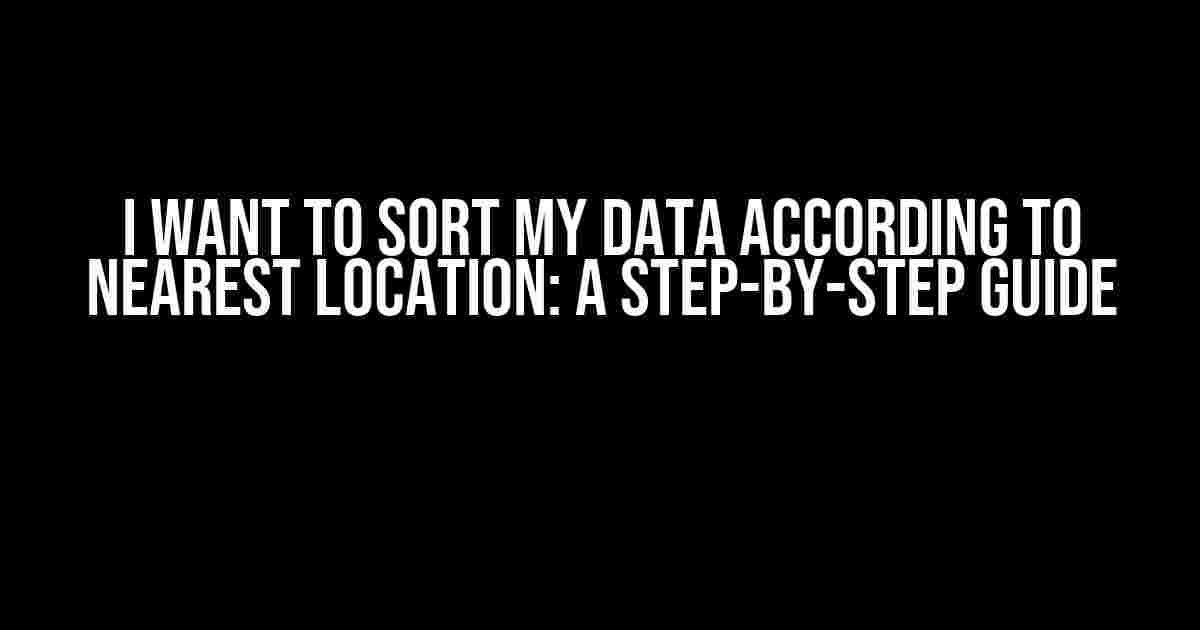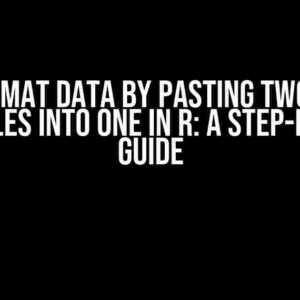Are you tired of sifting through endless lists of data, searching for the nearest location? Do you dream of a world where your data is organized, efficient, and easily accessible? Well, dream no more! In this comprehensive guide, we’ll show you how to sort your data according to nearest location, making your life easier and your data more manageable.
Why Sort by Nearest Location?
Sorting your data by nearest location can have a significant impact on your productivity and decision-making. Imagine being able to:
- Identify patterns and trends in your data based on geographical proximity
- Optimize logistics and supply chain management by locating nearby resources
- Enhance customer experience by providing location-based services and recommendations
- Streamline workflows and reduce distances between teams and collaborators
The benefits are endless, and with the right tools and techniques, you can unlock the full potential of your data.
Preparation is Key: Gathering Your Data
Before you can sort your data by nearest location, you’ll need to gather the necessary information. Make sure you have:
- A list of locations (addresses, coordinates, or zip codes)
- Associated data points (e.g., names, categories, or scores)
- A way to measure distance (we’ll cover this later)
If you’re working with a large dataset, consider using a spreadsheet or database management system to store and organize your data.
Measuring Distance: The Haversine Formula
To calculate the distance between two points on the surface of the Earth, we’ll use the Haversine formula. This formula takes into account the latitude and longitude coordinates of two points and returns the distance in kilometers.
function haversine(lat1, lon1, lat2, lon2) {
const R = 6371; // Radius of the Earth in km
const dLat = toRad(lat2 - lat1);
const dLon = toRad(lon2 - lon1);
const lat1Rad = toRad(lat1);
const lat2Rad = toRad(lat2);
const a = Math.sin(dLat/2) * Math.sin(dLat/2) +
Math.sin(dLon/2) * Math.sin(dLon/2) * Math.cos(lat1Rad) * Math.cos(lat2Rad);
const c = 2 * Math.atan2(Math.sqrt(a), Math.sqrt(1-a));
const d = R * c;
return d;
}
function toRad(x) {
return x * Math.PI / 180;
}
This formula assumes a spherical Earth, which is a reasonable approximation for most purposes. If you need a more precise calculation, consider using a more advanced formula or library.
Sorting Your Data: A Step-by-Step Process
Now that you have your data and a way to measure distance, it’s time to sort your data by nearest location. Follow these steps:
- Choose a reference point: Select a location that will serve as the center point for your sorting. This could be a headquarters, a warehouse, or any other location relevant to your dataset.
- Calculate distances: Use the Haversine formula to calculate the distance between each location in your dataset and the reference point.
- Store distances: Create a new column in your dataset to store the calculated distances.
- Sort data: Sort your dataset by the distance column in ascending order (smallest to largest).
- Filter and refine: Filter out locations that are beyond a certain distance threshold or refine your results based on additional criteria.
Voilà! Your data is now sorted by nearest location, making it easier to identify patterns, trends, and insights.
Real-World Applications: Putting Theory into Practice
Sorting your data by nearest location has countless applications across various industries. Here are a few examples:
| Industry | Application |
|---|---|
| Retail | Sorting customers by nearest store location to optimize marketing and supply chain management |
| Logistics | Identifying the closest warehouses or distribution centers to reduce shipping times and costs |
| Healthcare | Locating nearby medical facilities or healthcare providers for patients |
| Real Estate | Sorting properties by proximity to amenities, public transportation, or schools |
These are just a few examples of the many ways you can apply this technique to real-world problems.
Common Challenges and Solutions
When working with large datasets and complex geography, you may encounter some challenges. Here are a few common issues and their solutions:
- Performance issues: Use caching, indexing, or parallel processing to improve calculation speeds.
- Coordinate precision: Ensure accurate latitudes and longitudes by using reliable sources (e.g., GPS or mapping APIs).
- Edge cases: Handle edge cases, such as locations near the poles or on the International Date Line, by using specialized libraries or algorithms.
By being aware of these potential challenges, you can proactively address them and ensure a smooth sorting process.
Conclusion: Unleashing the Power of Location-Based Data
Sorting your data by nearest location is a powerful technique that can unlock new insights, optimize processes, and drive business decisions. With the Haversine formula and a step-by-step approach, you can tackle even the most complex datasets and uncover hidden patterns.
Remember, the key to success lies in preparing your data, measuring distances accurately, and refining your results. By following this guide, you’ll be well on your way to unleashing the full potential of your location-based data.
So, what are you waiting for? Start sorting your data today and discover the power of nearest location sorting!
Here are 5 Questions and Answers about “I want to sort my data according to nearest location” in a creative tone:
Frequently Asked Question
Get instant answers to your burning questions about sorting data by nearest location!
How do I sort my data to show the nearest locations first?
Easy peasy! To sort your data by nearest location, you’ll need to calculate the distance between each location and your current position. You can use a geocoding API like Google Maps or OpenCage to get the latitude and longitude coordinates of each location. Then, simply use a sorting algorithm to arrange the data in order of proximity. Voilà!
What if my data doesn’t have latitude and longitude coordinates?
No worries! If your data only has city names, postal codes, or addresses, you can still sort by nearest location. Use a geocoding API to convert the addresses to latitude and longitude coordinates, and then sort the data as usual. You can also use a library like geopy or geocoder to simplify the process.
How do I handle ties when multiple locations are equally close?
Good question! When multiple locations have the same distance, you can use additional criteria to break the tie. For example, you could sort by alphabetical order, popularity, or even a random shuffle. The choice depends on your specific use case and requirements. You can also consider using a secondary sorting key, like distance to a secondary location.
Can I use machine learning to improve location-based sorting?
Absolutely! Machine learning can help you refine your location-based sorting by incorporating additional factors like user behavior, preferences, and context. You can train a model to predict the most relevant locations based on user interactions, search history, or other signals. This can lead to more personalized and accurate results. Just remember to feed your model high-quality, location-rich data!
How do I optimize my sorting algorithm for large datasets?
When dealing with massive datasets, optimization is key! Consider using indexing, caching, or parallel processing to speed up your sorting algorithm. You can also use data structures like k-d trees or ball trees to efficiently search and sort large datasets. Additionally, leverage the power of distributed computing or cloud services to scale your sorting process. Remember, a faster algorithm is a happier algorithm!



